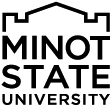
MINOT, N.D. – Even though American Sign Language (ASL) is Erica (Surette) Bailey’s first language, she waited over a year to find out she passed the initial section of the National Interpreter Certification (NIC) test.
“The test for the national certification has been around for a very long time, and it was overdue that they rehauled it and made a whole new testing process,” the Minot State special education instructor said. “I was actually part of the beta testing process and because of that, I waited a year and a half before I found out I had passed.”
Bailey took the first section of the three-part test at Minot State’s Academic Testing Center December 2021 and waited for results until June 2022. Next, she took the second test, also at the testing center.
“That wait was not as long, about two or three months,” she laughed. “From there, I had to schedule my performance test and took that in July 2022. In September 2023, I found out that I was officially a certified interpreter.”
“This certification is the highest level for the profession and is exceptionally rigorous,” said Holly Pedersen, Department of Special Education chair. “Erica handily passed the written exam. The performance exam is a much more complex process and required a trip to Minneapolis for a series of interpreting skill examinations. She received her passing results, as we knew she would.”
As one of the first testers for the new certification process, Bailey had the unique opportunity to provide feedback before joining the Registry of Interpreters for the Deaf National Interpreter Certification (RID NIC).
“It’s funny, because for years I have always said, you know, if the test was in ASL, I would pass with flying colors,” she said. “It’s the English language that trips me up every time. Then when they came out with the new certification process, half the test is now in ASL, which is something that needed to be done.”

Bailey interpreting at Recovery Reinvented 2023.
As CODA, an acronym for child of deaf adult that refers to an individual who is hearing and has d/Deaf parents, Bailey naturally grew up bilingual.
“I really learned ASL and English simultaneously,” she said. “But I consider English my second language because of my learning style. ASL and English — they’re two completely different languages.
“American Sign Language has its own syntax, grammatical sentence structure, all of it. ASL has its own set of rules. Even growing up, if I was taking a test, I would read the test in English and automatically interpret it into ASL.”
Growing up as her parents’ interpreter, Bailey naturally fell into the professional role as an adult.
“I married young to an active-military guy, and we moved all over the world. Even living overseas, interpreting jobs were desperately needed so I would take their proficiency tests to get that paper saying I was official,” she said. “In Germany, for example, there was a deaf spouse that needed an interpreter. In England, there was a foreign exchange student at a local university in London.”
Bailey joined Minot State as an adjunct professor five years ago, receiving her Bachelor of Applied Science in interpreting and sign language studies from the University in 2021. She moved into a faculty position in Fall 2022, joining fellow interpreter and special education instructor MariDon Sorum.
“The proliferation of unqualified people teaching American Sign Language has become so concerning that the National Association of the Deaf recently issued a position statement regarding the dangers of such practice,” said Pedersen. “MSU upholds this view and has faculty comprised of Deaf, CODA, and NIC individuals who also meet the required HLC – Higher Learning Commission — requirements. This is no easy feat, and our team works very hard to maintain this standard.
“Erica and MariDon are the only two NIC interpreters in Minot and the surrounding western part of the state. I am so proud they both represent Minot State and can share their expertise with our students.”
In addition to sharing that expertise, the duo also purposely schedules their classes on opposite days and times so one is available to interpret in the community as needed.
“I love my job here at Minot State teaching ASL and I love interpreting in the community,” said Bailey. “This morning, I had to interpret in court. There’s never a day that’s the same in my job. In a business-related environment, we’re trained to provide that communication. We’re the voice and the hands.”
About Minot State University
Minot State University is a public university dedicated to excellence in education, scholarship, and community engagement achieved through
rigorous academic experiences, active learning environments, commitment to public service, and a vibrant campus life.
Published: 10/16/23



